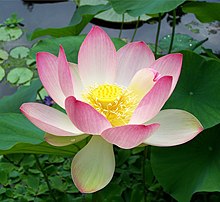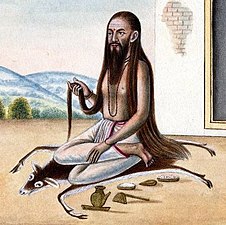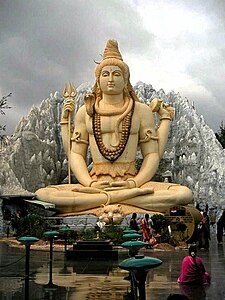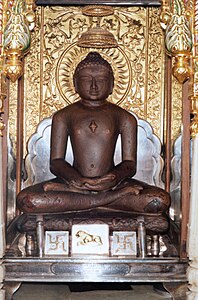Lotus position

Lotus position or Padmasana (
Variations include easy pose (Sukhasana), half lotus, bound lotus, and psychic union pose. Advanced variations of several other asanas including yoga headstand have the legs in lotus or half lotus. The pose can be uncomfortable for people not used to sitting on the floor, and attempts to force the legs into position can injure the knees.[2]
Etymology and history

The name Padmasana is from the Sanskrit पद्म Padma, "lotus" and आसन, Āsana, "posture" or "seat".[4][5] In Asian cultures,[6] the sacred lotus is used as a symbol of growth towards perfection and enlightenment as it is rooted in the mud at the bottom of the pond, but rises and blooms above the water.[7] In Chinese and Tibetan Buddhism, the pose is also called the "vajra position" (Skt. vajrāsana, Ch. 金剛座 jīngāngzuò).[8][9]
The pose is ancient and is described, along with other asanas (sitting postures), in the 8th century book Patanjalayogashastravivarana.[10] A figure seated in lotus position on a lotus flower is shown on dinar coins of Chandragupta II, who reigned c. 380–c. 415 AD.[11] The first tantric text to discuss posture (asana), the 6th-10th century Nisvasattvasamhita Nayasutra (4.11-17, 4.104-106), directs the meditator and "user of mantras" to sit in lotus or a similar posture.[12] The 15th century Hatha Yoga Pradipika states that the pose destroys all diseases, and that a yogin in the pose who retains the air breathed in through the nadi channels attains liberation.[13]
Sukhasana is from Sanskrit सुख sukha, meaning "pleasure" or "ease".[14] The 19th century Sritattvanidhi describes and illustrates the pose.[15] The name, and the more general name Yogasana ("Yoga pose") which may denote a variety of sitting poses, is found in much older documents as a meditation seat, such as in the 4th century Darshana Upanishad.[16]
Position
From sitting
Variations
Sukhasana (
In half lotus, अर्ध पद्मासन (Ardha Padmasana), one leg is bent and resting on the ground, the other leg is bent with the foot in lotus position. It is an easier meditation position than full lotus.[22]
In bound lotus, बद्ध पद्मासन (Baddha Padmasana), the practitioner sits in full lotus, and each hand reaches around the back to grasp the opposite foot.[23]
For psychic union pose, यओगमुद्रासन (Yogamudrasana), the practitioner bends forward in full lotus, bringing the forehead as close to the floor as possible.[24] The pose is both an asana and a mudra; easier variants begin from Ardha Padmasana.[25]
Variations of several other asanas such as
-
Sukhasana, easy pose
-
The sage Bharadvaja meditating in half lotus. 19th century
-
Baddha Padmasana
-
Yogamudrasana
-
Padma Sirsasana, lotus headstand
Effects
Lotus is one of the yoga poses that most commonly causes injury.
The yoga guru B. K. S. Iyengar notes that people unused to sitting on the floor will initially feel "excruciating" pain in the knees, but that this subsides with practice, until the pose becomes relaxing, both restful and alert and hence ideal for pranayama.[30]
Twentieth century advocates of some schools of yoga, such as Iyengar, made claims for the effects of yoga on specific organs, without adducing any evidence.[31][32] Iyengar claimed that Padmasana encourages blood circulation in the abdomen and lumbar region, toning the spine and abdominal organs.[33]
In art and culture
Asian art
In
-
Gautama Buddha
-
A Padmasana shrine, here of Pura Jagatnatha in Denpasar, Bali
Western culture
The scholar of religion Thomas Tweed wrote in 2008 that "the prevailing image of Buddhist practice has been the solitary meditator, eyes half closed, sitting in the lotus position."
See also
- Kukkutasana, cockerel pose, a balancing asana with the hands threaded through the folded legs of Padmasana
- List of asanas
- Maravijaya
- Padmasana (shrine)
- Zazen
References
- ISBN 978-0-02-863970-3.
- ^ PMID 24146758.
- ^ Baillie, Allan; Ostro, Suzanne (1999). "The Lotus". Tricycle, the Buddhist Review. 8 (3, Spring 1999). Retrieved 11 April 2020.
- ^ a b Iyengar 1991, pp. 129–133.
- ISBN 978-1-4008-6684-7. Archivedfrom the original on 6 September 2017.
- JSTOR 43483467.
- ^ Temple 2007, p. Chapter 1, The Symbolism of the Lotus Flower.
- ISBN 0-88139-951-5. Archived from the original(PDF) on 28 March 2012. Retrieved 17 December 2018.
- ^ Rinpoche, Patrul; Padmakara Translation Group (trans.) (1998). Words of My Perfect Teacher: A Complete Translation of a Classic Introduction to Tibetan Buddhism (Revised ed.). AltaMira Press. p. 440.
- ^ Mallinson & Singleton 2017, p. 97.
- ISBN 978-0-520-05991-7.
Reverse: Goddess, nimbate, sitting en face on lotus with legs folded in lotus position. Diadem or noose in right hand, lotus flower turned towards her in left. .. Legend: Śrī-vikramaḥ (the courageous one).
- ^ Mallinson & Singleton 2017, pp. 99–100.
- ^ Mallinson & Singleton 2017, p. 111.
- ISBN 978-81-222-0089-8.
- ISBN 81-7017-389-2.
- ISBN 978-81-208-3349-4.
- OCLC 216937520.
- ISBN 978-0863184208.)
{{cite book}}: CS1 maint: multiple names: authors list (link - ISBN 978-1-60497-718-9.
- ^ Costello, Nikki (25 March 2013). "Sukhasana Isn't All Easy". Yoga Journal. Retrieved 17 November 2022.
- ^ Maharsi, Ramana (1962). The teachings of Bhagavan Sri Ramana Maharshi in his own words. Rider. p. 134.
- ISBN 978-81-86336-14-4. Archived from the original(PDF) on 7 August 2015. Retrieved 11 November 2018.
- ISBN 81-7017-389-2.
- ^ Saraswati 2004, pp. 182–183.
- OCLC 32442598.
- ^ Iyengar 1991, pp. 137–139, 142–143, 204–206, 230–237.
- ^ Iyengar 1991, pp. 98–99, 270–276.
- PMID 22869991.
- ^ Cole, Roger (5 February 2019) [2007]. "How to Protect the Knees in Lotus and Related Postures". Yoga Journal.
- ^ Iyengar 1991, p. 131.
- ^ Newcombe 2019, pp. 203–227, Chapter "Yoga as Therapy".
- ^ Jain 2015, pp. 82–83.
- ^ Iyengar 1991, pp. 131–132.
- ^ "Buddhas Crossed Legged Position - Lotus Position". Asian Art. Retrieved 11 April 2020.
One of the most popular seated positions of Lord Buddha is crossed legged position. In various Buddhism traditions like Mahayana and Theravada Buddhism, Lord Buddha is often shown with his ankles tucked and different hand and fingers position. The seated Crossed legged position is known as Lotus position.
- ^ "Lotus-Enthroned Buddha Akshobhya, the Transcendent Buddha,8th–early 9th century". Metropolitan Museum of Art. Retrieved 2 August 2019.
- ^ "Representation of: Buddha (Śākyamuni/Gotama/Shaka)". British Museum. Retrieved 2 August 2019.
- ^ Dehejia, Vidya (February 2007). "Recognizing the Gods". Metropolitan Museum of Art.
- ISBN 0751368709.
- ISBN 978-1462900923.
- ISBN 978-0-8108-6558-7.
Tirthankaras are depicted in only two postures: seated in the classic lotus position (padmasana), which represents the Tirthankara preaching in the assembly hall (samavasarana), and standing in the kayotsarga posture, which represents abandoning the body.
- S2CID 192174202.
- ISBN 9781448139361.
- ISSN 0022-3840.
- ^ a b c d Lane, Mega (9 October 2003). "The tyranny of yoga". BBC.
- ISBN 978-0-7890-2300-1.
Sources
- ISBN 978-1855381667.
- OCLC 878953765.
- OCLC 928480104.
- ISBN 978-1-78179-661-0.
- ISBN 978-81-85787-08-4.
- Temple, Anton (2007). Becoming the lotus: a systematic course of stretching and posture leading to the safe and comfortable adoption of the lotus posture, including a guide to the symbolism and spiritual meaning behind the lotus flower. Merkur. ISBN 978-1-885928-18-4.












